The last Russian pre-dreadnoughts:
The Andrei Pervozvanny class were the last Russian Imperial Navy pre-dreadnought battleships, tailored for the Baltic Fleet. They conceptualized by the Naval Technical Committee in 1903 deriving from the Borodino-class battleships but massive displacement and a secondary armament that classed them almost as “semi-dreadnoughts”. However the 1905 Russian led to many redesigns and contradictory orders and delays and they ended obsolete when entering service 1911, a whooping six years after the first Dreadnoughts was launched. In fact the Gangut class was in construction already at that time.
They were pretty inactive until the 1917 revolution, and were captured by the Bosheviks, all their officers killed in the process. They formed the bulk of the Ice Cruise of 1918, Andrei Pervozvanny helping mutineers of Krasnaya Gorka the next year. They were also instrumental in the Kronstadt rebellion of 1921, but due to the lack of money for maintenance, the Pervozvanny class battleships were just scrapped in 1923, after a mere ten years of active service.
Development and design of the Pervozvanny class
It all started with the five Borodino-class battleship planned to leave their slipways in 1904, giving the impetus from the Naval Technical Committee (NTC) to organize a conference, late in 1902 about the ambitious new Russian Navy 20-year shipbuilding program. Budgets were needed for four battleships FY1903-1904, for Black Sea Fleet (which became the Evstafi class) and two other for Baltic Fleet (our subject). Recommendations were given and the NTC chose to try a much larger versions of the Borodinos with secondary guns 8-inch in caliber (203 mm) instead of the classic 6-inch of the previous class, and more than the 7.5 in of their immediate predecessors. The first scheme asked for 16,500-long-ton (16,765 t) of displacement to reach.
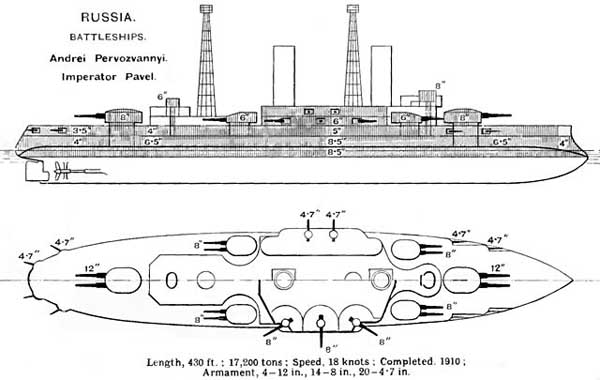
Brassey’s diagram of the Pervozvanny class as completed, with the corbel masts
Early in 1903, the General Staff was proposed sketch from the designer of the Borodino class, Dmitry Skvortsov, adopting NTC design and issuing more detailed requirements:
-Main battery of two twin 12 in
-Second battery of 8-in guns in twin turrets
-Tertiary of twenty 75-mm (3 in) guns
-9-inch (229 mm) waterline belt, upper strake 7-inch (180 mm), 8 in for the base.
-Top speed of 18 knots (33 km/h; 21 mph)
-Maximum draught 26 feet (7.9 m) (for the Suez Canal).
-Lowered superstructure by one deck.
Chief engineer Skvortsov worled on the project and presented his blueprints in June 1903 and denounced the excessive drag of the hull shape imposed by Alexey Krylov. The latter eventually departed for the Far East and NTC approved the design. By July, 4, 1903 the NTC failed to inform master builder Sergey Ratnik of Baltic works about the new ships, but construction was approved. Ratnik tried to warn NTC over overweight caused by internal arrangements, adding 500–600 long tons more, dismissed in turn. In August 1903 the NTC had the final design ready after afew adjustments and on the 29, the Navy Ministry awarded construction contracts. Both Galernyi Shipyard and Baltic Works were contracted to delover respectively Andrei Pervozvanny and Imperator Pavel I.
Construction of the Pervozvanny class
Final blueprint were approved and work started by March 15 1904 for the first, while for her sister ship Imperator Pavel I it was on October 27. As usual, specialized yards were contracted for equipments, the Franco-Russian Works providing the powerplant and Coal-firing boilers. The NTC bureaucracy for some unclear reasons ordered two different specifications for the powerplants, and the first ship was laid down in May 1905, as the 1905 revolution erupted in between.
The laying-down ceremony was simply cancelled for Imperator Pavel I. Both progressed at a slow pace, with many redesign demands and counter orders, implying rework and long delays, partly due the internal situation and political changes. While Andrei Pervozvanny was completed, the yard received seventeen design changes to comply, linked notably to the removal of all apparatus for mines, since the explosion of the battleship Petropavlovsk in April 1904. These mines were intended to protect the battleships at anchor, in addition to their nets. By 9 November 1904 the use of mines on battleships was forbade and in December the stern torpedo tubes were to be discarded, keeping only the bow and broadside tubes, changed to the broadsides ones in mid-1905.
The NTC this year nevertheless inundated the yards with conflicting orders, with reports of the war. Small-calibre guns for example were to be replaced by May 1905 by more 75 mm guns and no 47 mm, using the upper-deck casemate, ans the latter were replaced in turn by 120 mm guns on 30 May after Tsushima. It was established that unarmoured plating to preserve stability generated splinters that can cripple the ammunition hoists and boiler exhausts. Additional armour was asked for, making the displacement rose to 17,151 long tons, by late 1905. In May 1906, the central 8 in turrets were replaced by single casemate guns, while gun embrasures and portholes were deleted by fear of flooding in case of a list. Ventilation and therefore habitability became an issue and guns relocations demanded many adjustments and rebuilding of the superstructure.

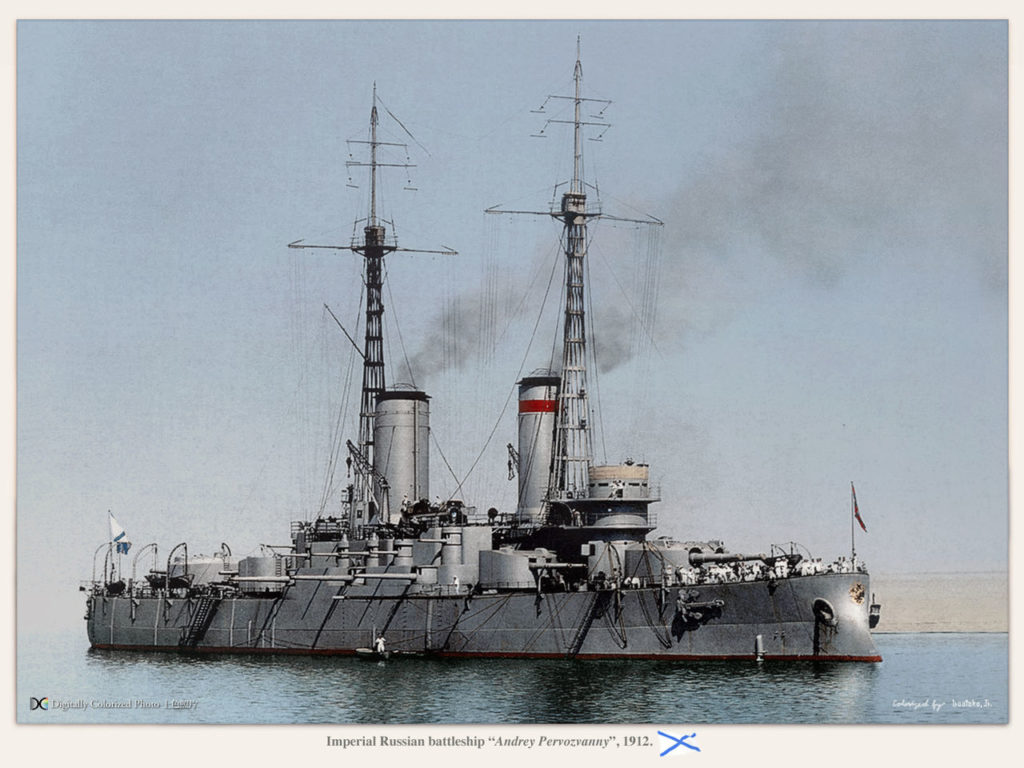
Andrei Pervozvanny as built in 1912 – The original and the colorized version by iroo toko jr.
Reports from the Battle of the Yellow Sea conducted the NTC to conclude that to avoid a single hit disabling a mast Lattice masts, just introduced on the South Carolina-class battleships, seemed to give a more redundant structure in case of a hit, and the yards were asked to built two per ships, making these Russian pre-dreadnoughts also the first and last with these corbel masts. The difference was the Russians decided on thinner masts, which proved troublesome in service: They vibrated and the lookouts and signals positions were plagued by smoke. It should be noted that both captains had very different opinion about them. Imperator Pavel I’s commander accepted to quickly remove them in three days while Fleet commander Admiral Nikolai Essen pressed the other to do the same in August 1914, but the ships kept their lower baskets cut at different heights.
Design of the Pervozvanny class
Hull and armour protection
The Pervozvanny class hull was subdivided in 17 transverse watertight bulkheads while the engine rooms were separated by a centerline longitudinal bulkhead. Both also had a double bottom and a 4 feet (1.2 m) metacentric height.
Based on Battle of Tsushima battle reports Krupp cemented armor was adopted for a more refined and thicker belt. The main one reached 216 mm, the upper one 127 mm. The main turrets only had 8 inches (203 mm) and the deck 38 mm. None of these figures went to 12 inches which would have been coherent to protect the central citadel. The dreadnought’s armor ranged from 280 to 305 mm, however the smaller Evstafi class also had 10 inches (254 mm) armor for the main turrets and casemates. So overall, protection was rather weak for battleships, compensated it was thought by the nature of Krupp armor, supposed to equate 50-100 mm more armor thickness.
The Belt was 4 to 8.5 inches (102–216 mm) depending on the location, thicker at the center and between barbettes. The upper belt was 3.1–5 inches (79–127 mm) thick, Casemates had walls 3.1–5 inches (79–127 mm) thick. Even the massive Conning tower only had 4–8 inches (102–203 mm) thick walls. Perhaps because it was massive and tall. There was no “true” command bridge above or below. The main gun turrets had 10 inches faces and 8 in sides (254–203 mm). The main gun barbettes were protected by 4–5 inches (102–27 mm) and the the secondary gun turrets were protected by 5–6 inches (127–52 mm) thick armor.
Powerplant
The two Russian Battleships were propelled by two sets of 4-cylinder vertical triple-expansion steam engines, fed by 25 Belleville boilers at a working pressure of 285 pounds per square inch. They delivered a total output of 17,600 indicated horsepower (13,100 kW). During sea trials they were forced-heated to produce 17,635 ihp (13,150 kW), giving them a top speed of 18.5 knots (34.3 km/h; 21.3 mph). For autonomy, normal load was 800 long tons (810 t) of coal, enough for 1,300 nautical miles (2,400 km; 1,500 mi) at the reduced cruise speed of 12 knots (22 km/h; 14 mph). In wartime, this could be raised to 1,500 long tons (1,500 t) enough for 2,400 nautical miles (4,400 km; 2,800 mi). Contrary to pre-1905 Russian battleships they never had to undetake a long journey on the other side of the globe, they spent all their active career in the confines of the Baltic sea.
Armament
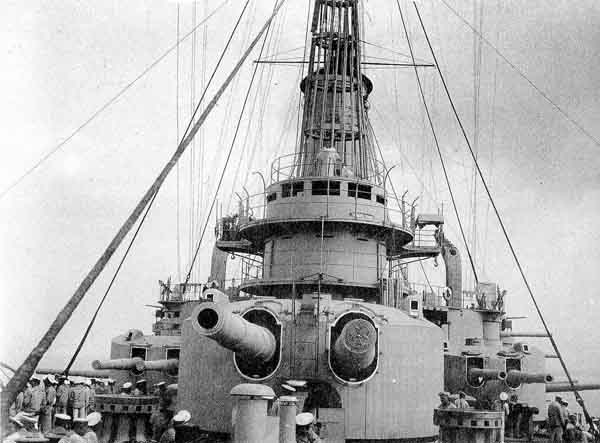
Pervozvanny main and secondary turrets, forming a chasing six guns volley.
Main armament comprised two twin turrets housing 12-inch (305 mm) Model 1895, 40-caliber Obukhoff guns fore and aft in a classic configuration at the same deck level. Maximum elevation was 35° down to -5°. 80 rounds was stored per gun, so 320 total of the standard AP type, and optional HE. They fired at a round per minute on average. The amazing twin level secondary armament comprised no less than fourteen 8-inch (203 mm)/50 Model 1905. Eight were mounted in twin-gun turrets at both corners of the battery superstructure. Since for stability, the amidships turrets were removed, it allowed to place six guns in casemates.
The second level of secondary armament was a duel-purpose one as it was considered fit to deal with destroyers torpedo boats, combing quick-firing and long range. These twelve 120 mm (4.7 in) were mounted in casemates, above the 8-in guns. This was completed by two 6-pdr (47 mm), also to deal with small ships and salute guns. From the original plan of four TTs, only the two underwater broadsides 450mm (17.7 in) were kept with six torpedoes in reserve.
Specifications of the Pervozvanny as built |
|
| Dimensions | 140.2 m x 24.38 m x 8.23 |
| Displacement | 17,320 LT (17,600 t), 18,580 LT deep load |
| Crew | 956 |
| Propulsion | 2 shafts VTE 25 CF Belleville WT boilers, 17,600 ihp (13,100 kW) |
| Speed | 18.5 knots (34.3 km/h; 21.3 mph) |
| Range | 2,100 nmi (3,900 km; 2,400 mi) at 12 knots |
| Armament | 4 x 305mm (2×2), 14 x 203mm, 12 x 120mm, 1 x 47mm, 2 TTs 21-in bds |
| Armor | Belt 102–216 mm, Casemates 79–127 mm, CT 102–203 mm, Main turrets 203–54 mm, barbettes 102–27 mm, Sec. turrets 127–52 mm. |
The Pervozvanny in action
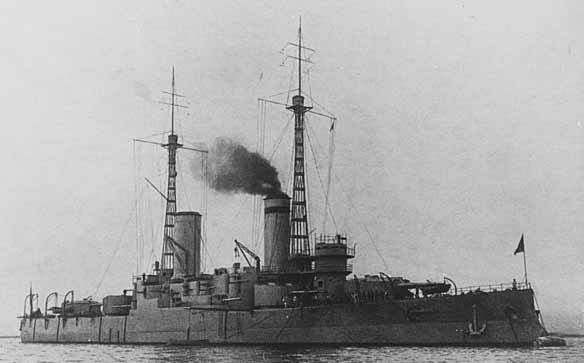
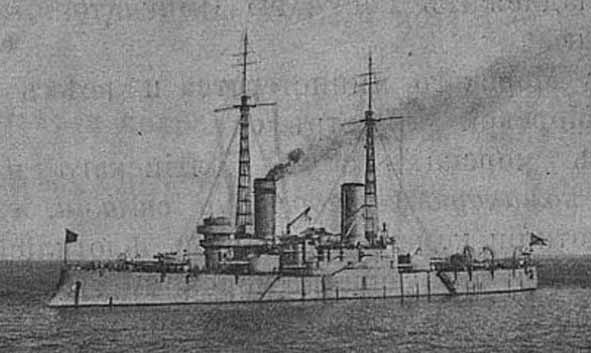
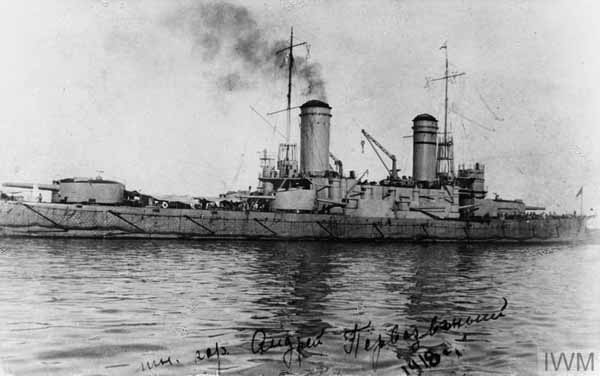
https://en.wikipedia.org/wiki/Andrei_Pervozvanny-class_battleship
Career of the Andrei Pervozvanny
Andrei Pervozvanny was officially started at the Admiralty Shipyard in Saint Petersburg on 15 March 1904 but officially laid down on 11 May. just like other ships in constructions at the time in many yards she was delayed by labor strikes during and following the 1905 Revolution. She was at least launched on 30 October 1906, two years and a half after being laid down, making initial sea trials in September 1910, completed one month later, but after fitting out she entered service on 10 March 1911. Andrei Pervozvanny was in the Baltic Fleet, visiting like her sister ship Copenhagen in September 1912. In September 1913 she toured UK (Portland), France (Cherbourg) and Norway (Stavanger) but ran aground on Odensholm Island banks, off the Estonian coast. It happened on 1 July 1914 and she was undeegoing repairs when the war broke out. Modifications included the removal of her lattice masts, light topmasts fitted instead.
Andrei Pervozvanny rarely fired her guns but in exercizes as the squadron remained inactive during the war. The commander’s naval strategy was defensive; The ships were kept for a sortie in case German minesweepers would try to clear the minefields the Russian Navy laid at the start of the war, covered by the Pervozvanny and other ships. Their role was not to seek out an open sea engagement with the German fleet,, despite the fact it was mostly committed to the north sea. In early 1915 the ships received torpedp nets in case a submarine would slip through, and her torpedo tubes were removed like her sister ship in January 1916. By late 1916 she also received four 3 in (76 mm) anti-aircraft guns.
In March 1917, news of the revolution the preceding month in St Petersburg, with the baltic navy cruiser Aurora taking part in it, the ship’s crew joined the mutiny of the whole Baltic Fleet, started on her sister ships, in Helsinki. Her officers were murdered. Later, the Treaty of Brest-Litovsk was signed, requiring the Soviets to either evacuate Helsinki in March 1918 or have them interned in Finland. This last option was chosen, despite the fact the gulf of infland was freoen over, they way opened by an icebreaker. Andrei Pervozvanny and Respublika (ex-Pavel I), were part of the second group which depared Helsinki on 5 April to reached Kronstadt on 1 April, the “Ice Voyage”.
During the October Revolution of 1918, Pervozvanny remained on active duty in the Red Navy, but took litte part in the Civil War. On 13-15 June 1919, Andrei Pervozvanny and Petropavlovsk however made a sortie, shelling the Fort of Krasnaya Gorka, as its garrison rebelled against the Bolsheviks, joining the “white russians”. Pervoizvanny fired broadsides after broadsises in anger, the first time it happened during her career, a hundred and seventy 12-inch shells and four hundred eight 8-inch shells. The garrison ultimately surrendered two days after, on 17 June. Leon Trotsky indeed negociated indeed their safe release; however once out, they were all machine-gunned.
Andrei Pervozvanny continued operations in the baltic until she was attacked by the Royal Navy, torpedoed by C.M.B. 31 or C.M.B. 88 (bot claimed her hits), during the night of 17/18 August 1919. By that time, the battleship was anchored in Kronstadt. She received a torpedo hit on the port bow. Her ASW compartimentation did her job and she listed only from 2 feet (0.6 m) down by the bow.
The British allegedly claimed she was hit three times but Russian reported that two in fact struck the harbor wall behind. The battleship survived, although flooded and sinking to the bottom, whereas Victoria Cross were awarded to the CMB’s Commander Claude Congreve Dobson and Lieutenant Gordon Charles Steele. Ultimately, Pervozvanny was raised and docked but never fully repaired due to the lack of resources, other priorities, and another hit While under repair. This time she was near-missed by an airplane bomb during the British 3 September air raid. It was decided to retire her artillery and have her scrapped instead. Andrei Pervozvanny’s dismlantling started on 15 December 1923 but she was striken only by 21 November 1925.
Career of Imperator Pavel I
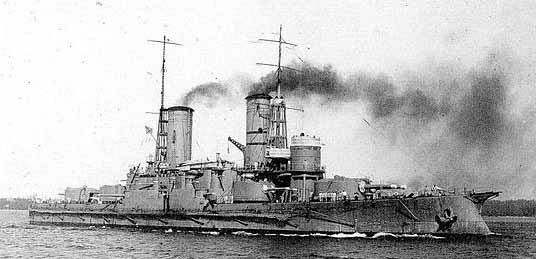
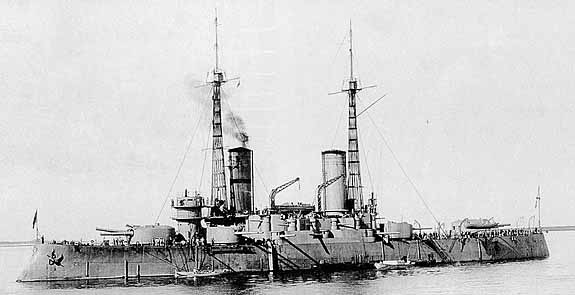
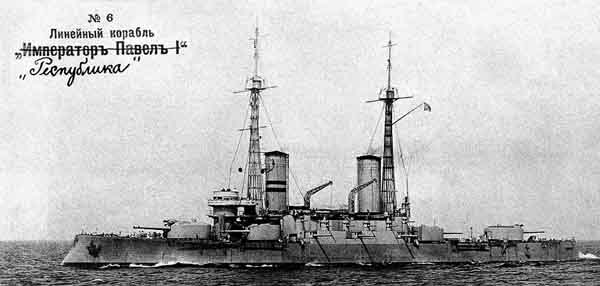
Imperator Pavel I construction took place in the Baltic Works, Saint Petersburg, starting on 27 October 1904, and in between design changes was almost stopped by workers’s striked during and after the 1905 Revolution. At last she was launched on 7 September 1907, but multiple redesigns led to a completion in October 1910, and she only entered service on 10 March 1911, for mover modifications and new official trials completed in October 1911, one year after completion.
For her first assignation with the baltic fleet, Imperator Pavel I visited Copenhagen in September 1912, Portland, Cherbourg, and Stavanger the other years. From August 1914 Pavel I was deployed to cover minelaying operations at the entrance of the Gulf of Finland. There were almost no sorties from the Russian naval Baltic squadron, which stayed in the defensive, at least until the end of the war. This was however quite a formidable force, comprising the four Gangut-class dreadnoughts and two Andrei Pervozvanny-class predreadnoughts. Thir main task was to surge to counter any intrusion in the entrance to the Gulf of Finland. In aaddition to the lattice masts partial removal (stopped below the funnel’s caps), torpedo nets were fitted, this time in early 1915 while the broadsides torpedo tubes were removed in January 1916. By late 1916 also, four 3 in (76 mm) anti-aircraft guns were added on the superstructure.
In 1917, the events in the country stroke all the baltic ships as well as the Black sea ships: But the Pavel I had a role to play in the Revolution, as it was a committe of disgruntled sailors onboard the battleship which instigated mutiny in the whole the Baltic Fleet, by then stationed in Helsinki. It started on 16 March 1917, soon after the February Revolution in Saint Petersburg. Officers were arrested, shot or jailed, and Pavel I was renamed Respublika (Republic) on 29 April. The Brest-Litovsk treaty imposed by the entente on Russia required the Soviets to evacuate the Helsinki naval base in March 1918. The other choice left to them was to have their ships interned in Finland, now independent and neutral. However that that time the Gulf of Finland was frozen over.
Respublika and Andrei Pervozvanny led the second group, departing on 5 April to reach Kronstadt the 10th in which was called the ‘Ice Voyage’, their way open by an icebreaker and their wight doing the rest. Upon arrival, Pavel I was laid up in October 1918. The main reason was the lack of manpower; Rusting, priorities for maintenance going to the Ganguts instead, the comitte eventually decided to have the ship not stricken from the lists yet, bu scrapped from 22 November 1923. Respublika was formally stricken only on 21 November 1925, but two of the 8-inch turrets were installed at the coastal battery No. 9 near Leningrad in the 1930s, scrapped today athough their concrete shafts remains.
Src/Read more
//navsource.narod.ru/photos/01/033/index.html
//www.battleships-cruisers.co.uk/imperator_pavel.htm
//en.wikipedia.org/wiki/Andrei_Pervozvanny-class_battleship
//www.wunderwaffe.narod.ru/Magazine/BKM/Pavel_1/index.htm
Conway all the world’s fighting ships 1865-1905
Friedman, Norman (2011). Naval Weapons of World War One. Barnsley
Gutthridge, Leonard. F. (2006). Mutiny: A History of Naval Insurrection.
Head, Michael (2009). “The Baltic Campaign, 1918–1920, Pts. I, II”. Warship International.
McLaughlin, Stephen (2003). Russian & Soviet Battleships. Naval Institute Press.
Melnikov, Rafail. M. (2003). Lineyny korabl “Andrey Pervozvanny” (1906–1925)
Melnikov, Rafail. M. (2005). Lineyny korabl “Imperator Pavel I” (1906–1925)
Taras, Alexander (2000). Ships of the Imperial Russian Navy 1892–1917 Library of Military History
Vinogradov, Sergei E. (1998). “Battleship Development in Russia from 1905 to 1917”. Warship International.
Afonin, N. N.; Kuznetsov, L. A. (1996). Lineyny korabl “Andrey Pervozvanny”
Shirokorad, A. B. (1997). Korabelnaya artilelleriya Rossiyskogo flota 1867–1922.
The models corner
1/200 142 GPM Andrei Pervozvanny cardstock paper kit
Kombrig 1:700 models Pavel I & Pervizvanny – review


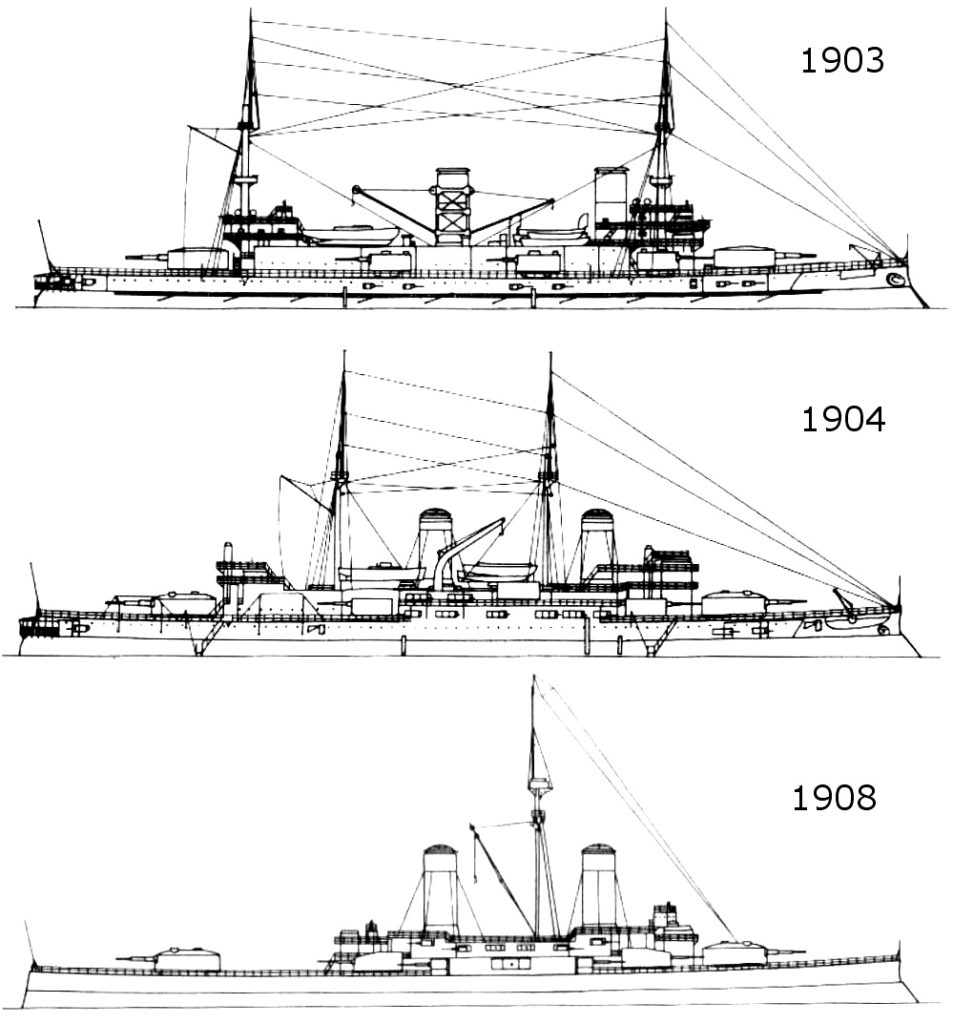
 Latest Facebook Entry -
Latest Facebook Entry -  X(Tweeter) Naval Encyclopedia's deck archive
X(Tweeter) Naval Encyclopedia's deck archive Instagram (@navalencyc)
Instagram (@navalencyc)





 French Navy
French Navy Royal Navy
Royal Navy Russian Navy
Russian Navy Armada Espanola
Armada Espanola Austrian Navy
Austrian Navy K.u.K. Kriegsmarine
K.u.K. Kriegsmarine Dansk Marine
Dansk Marine Nautiko Hellenon
Nautiko Hellenon Koninklije Marine 1870
Koninklije Marine 1870 Marinha do Brasil
Marinha do Brasil Osmanlı Donanması
Osmanlı Donanması Marina Do Peru
Marina Do Peru Marinha do Portugal
Marinha do Portugal Regia Marina 1870
Regia Marina 1870 Nihhon Kaigun 1870
Nihhon Kaigun 1870 Preußische Marine 1870
Preußische Marine 1870 Russkiy Flot 1870
Russkiy Flot 1870 Svenska marinen
Svenska marinen Søværnet
Søværnet Union Navy
Union Navy Confederate Navy
Confederate Navy Armada de Argentina
Armada de Argentina Imperial Chinese Navy
Imperial Chinese Navy Marinha do Portugal
Marinha do Portugal Mexico
Mexico Kaiserliche Marine
Kaiserliche Marine 1898 US Navy
1898 US Navy Sovietskiy Flot
Sovietskiy Flot Royal Canadian Navy
Royal Canadian Navy Royal Australian Navy
Royal Australian Navy RNZN Fleet
RNZN Fleet Chinese Navy 1937
Chinese Navy 1937 Kriegsmarine
Kriegsmarine Chilean Navy
Chilean Navy Danish Navy
Danish Navy Finnish Navy
Finnish Navy Hellenic Navy
Hellenic Navy Polish Navy
Polish Navy Romanian Navy
Romanian Navy Turkish Navy
Turkish Navy Royal Yugoslav Navy
Royal Yugoslav Navy Royal Thai Navy
Royal Thai Navy Minor Navies
Minor Navies Albania
Albania Austria
Austria Belgium
Belgium Columbia
Columbia Costa Rica
Costa Rica Cuba
Cuba Czechoslovakia
Czechoslovakia Dominican Republic
Dominican Republic Haiti
Haiti Hungary
Hungary Honduras
Honduras Estonia
Estonia Iceland
Iceland Eire
Eire Equador
Equador Iran
Iran Iraq
Iraq Latvia
Latvia Liberia
Liberia Lithuania
Lithuania Mandchukuo
Mandchukuo Morocco
Morocco Nicaragua
Nicaragua Persia
Persia San Salvador
San Salvador Sarawak
Sarawak Uruguay
Uruguay Venezuela
Venezuela Zanzibar
Zanzibar Warsaw Pact Navies
Warsaw Pact Navies Bulgaria
Bulgaria Hungary
Hungary

 Bundesmarine
Bundesmarine Dutch Navy
Dutch Navy Hellenic Navy
Hellenic Navy Marina Militare
Marina Militare Yugoslav Navy
Yugoslav Navy Chinese Navy
Chinese Navy Indian Navy
Indian Navy Indonesian Navy
Indonesian Navy JMSDF
JMSDF North Korean Navy
North Korean Navy Pakistani Navy
Pakistani Navy Philippines Navy
Philippines Navy ROKN
ROKN Rep. of Singapore Navy
Rep. of Singapore Navy Taiwanese Navy
Taiwanese Navy IDF Navy
IDF Navy Saudi Navy
Saudi Navy Royal New Zealand Navy
Royal New Zealand Navy Egyptian Navy
Egyptian Navy South African Navy
South African Navy






























 Ukrainian Navy
Ukrainian Navy dbodesign
dbodesign